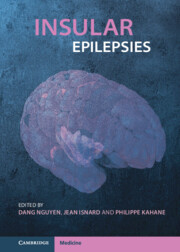Book contents
- Insular Epilepsies
- Insular Epilepsies
- Copyright page
- Contents
- Contributors
- Foreword
- Chapter 1 A Brief History of Insular Cortex Epilepsy
- Section 1 The Human Insula from an Epileptological Standpoint
- Section 2 The Spectrum of Epilepsies Involving the Insula
- Section 3 Noninvasive Investigation of Insular Epilepsy
- Chapter 13 Noninvasive Electrophysiological Investigations in Insular Epilepsy
- Chapter 14 Structural Imaging of Insular Epilepsy
- Chapter 15 PET and SPECT in Insular Epilepsy
- Chapter 16 Neuropsychology of Insular Epilepsy
- Section 4 Invasive Investigation of Insular Epilepsy
- Section 5 Surgical Management of Insular Epilepsy
- Index
- References
Chapter 15 - PET and SPECT in Insular Epilepsy
from Section 3 - Noninvasive Investigation of Insular Epilepsy
Published online by Cambridge University Press: 09 June 2022
- Insular Epilepsies
- Insular Epilepsies
- Copyright page
- Contents
- Contributors
- Foreword
- Chapter 1 A Brief History of Insular Cortex Epilepsy
- Section 1 The Human Insula from an Epileptological Standpoint
- Section 2 The Spectrum of Epilepsies Involving the Insula
- Section 3 Noninvasive Investigation of Insular Epilepsy
- Chapter 13 Noninvasive Electrophysiological Investigations in Insular Epilepsy
- Chapter 14 Structural Imaging of Insular Epilepsy
- Chapter 15 PET and SPECT in Insular Epilepsy
- Chapter 16 Neuropsychology of Insular Epilepsy
- Section 4 Invasive Investigation of Insular Epilepsy
- Section 5 Surgical Management of Insular Epilepsy
- Index
- References
Summary
Functional imaging has been reported to have a limited impact in the diagnosis of insular epilepsies, showing unspecific or misleading features. However, recent studies have demonstrated that PET and SPECT may be helpful in identifying abnormalities pointing to insula and guiding invasive monitoring. FDG-PET may detect a focal or regional hypometabolism in about half of the cases, and its localization value is greatly improved by the coregistration with MRI. In addition, PET may help lateralize the insular seizures, and statistical analysis contributes to differentiate them from temporal and frontal lobe seizures. SEEG strategy benefits from PET findings, as electrode implantation within the main hypometabolic areas improves the concordance rate between the PET pattern and the localization of the epileptogenic zone. Finally, PET is a reliable tool for the detection of insular focal cortical dysplasias, especially in MRI negative cases. These findings are helpful for planning surgery in these difficult-to-treat epilepsies. SPECT regional cerebral blood flow (rCBF) imaging under both interictal and ictal conditions is a mainstay of localization of epileptogenic foci in subjects with medically intractable epilepsy contemplating surgical ablation of disease-causing focal brain anomalies. Its performance is excellent in patients with mesial temporal lobe epilepsy, but neocortical foci remain harder to evaluate, in particular because of their tendency to generalize more rapidly than the former. The specific case of insular epilepsy has been studied in a limited number of studies only, reporting on a few tens of patients overall. Although this limits the possibility of conducting well-powered statistical analysis of the sensitivity and specificity of interictal/ictal SPECT rCBF imaging in this condition, available results converge towards the conclusion that this technique offers useful and important information in the pre-operative assessment of patients afflicted by that often difficult to characterize disease.
- Type
- Chapter
- Information
- Insular Epilepsies , pp. 179 - 193Publisher: Cambridge University PressPrint publication year: 2022



